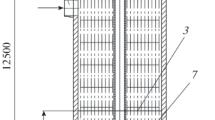Abstract
Results are presented from a comparison of the design, weight, size, and process characteristics of moisture separators-reheater (MSR) for steam-turbine units at nuclear power plants with pressurized water power reactors (VVER), which are based on a cartridge-type tube system (MSR-CTS) and are currently used, with a promising apparatus based on a manifold-platen tube system (MSR-MPS) with provisions for the heating-steam condensation and the removal of noncondensable gases released during condensation. The MSR-MPS separator considered in the article differs from the MSR-P, developed at the beginning of the 21st century by specialists of VNIIAM, by the design of the tube bundle in the reheater stages and the operation of the heating-steam condensation paths. Elimination of the thermohydraulic nonuniformity in and stable and reliable operation of tube bundles is MSR-MPS reheaters without temperature fluctuations and steam-gas plugs are attained due to dissolution of the gases released during steam condensation in the condensate cooling section. The tube bundles of each stage of the MSR-MPS reheater is a single section where steam condensation and condensate cooling are combined. This design eliminates all heating-steam losses since purging is not provided. In addition, heating-steam flowrates in reheater stages decrease due to the condensate cooling, and the effectiveness of the apparatus and the efficiency of the turbine unit increase. Application of MSR-MPS will considerably decrease the footprint of the system of intermediate separation and reheat of steam in the turbine building and will also reduce the apparatus’s metal intensity by half as compared to the MSR-CTS system. The outlined capabilities of the MSR-MPS system are essential in the reconstruction (upgrading) of existing and development of new power units at NPPs and optimization of design, process, and space-layout solutions for intermediate separation and reheat of steam systems for operating and newly designed steam-turbine units with a corresponding reduction in annual reduced costs, including CAPEX and OPEX.





Similar content being viewed by others
REFERENCES
V. L. Mukhachev, V. F. Desyatun, and O. I. Nazarov, “Operation optimization of the K-500-60/3000 turbine reheat system based on the purge of the heating steam path of the second superheat stage SPP-500-1,” Tr. TsKTI, No. 269, 87−93 (1992).
RTM 108.020.107-84. Moisture Separators-Reheaters of Nuclear Power Plant Turbines (Minenergomash, Moscow, 1986).
RD 24.035.05-89. Thermal and Hydraulic Calculation of Nuclear Power Plant Heat Exchange Equipment (Minenergomash, Moscow, 1989).
A. S. Shamarokov, V. I. Zhingel’, L. M. Andreev, O. A. Avdeev, and D. A. Drobchenko, “Moisture separator-reheater,” RF Patent No. 2521699, Byull. Izobret. No. 34 (2018).
Author information
Authors and Affiliations
Corresponding author
Additional information
Translated by T. Krasnoshchekova
Rights and permissions
About this article
Cite this article
Shamarokov, A.S., Zorin, V.M., Pustovalov, S.B. et al. The New Generation of Moisture Separators-Reheaters for Steam-Turbine Units of Nuclear Power Plants (NPP) with VVER-Reactors. Therm. Eng. 69, 691–701 (2022). https://doi.org/10.1134/S0040601522080080
Received:
Revised:
Accepted:
Published:
Issue Date:
DOI: https://doi.org/10.1134/S0040601522080080



